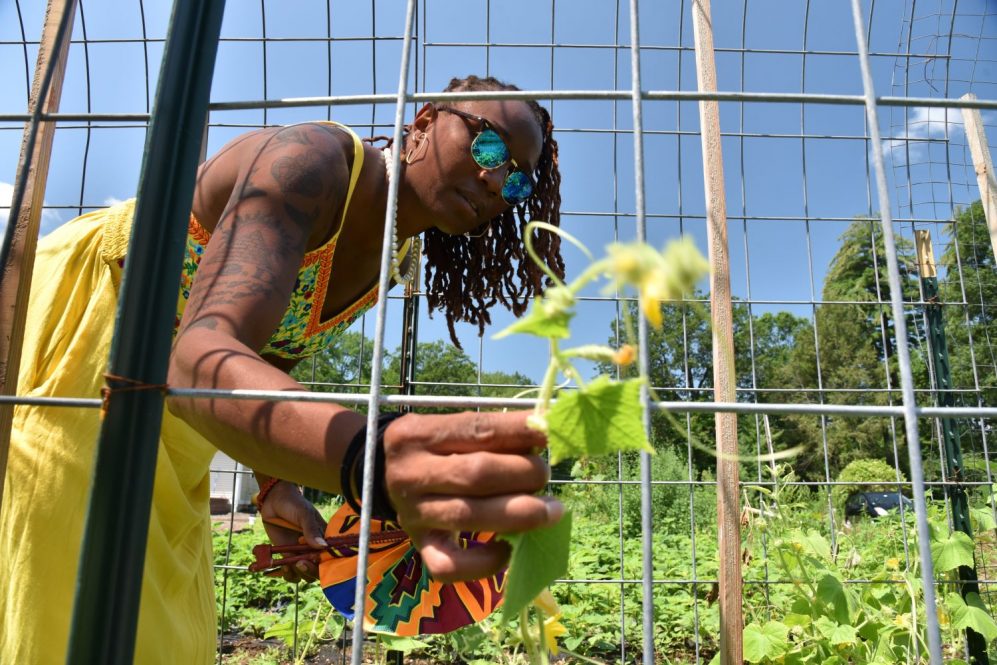A UConn Extension-led program provided professional development for people of color to serve as leaders in conservation for their communities this summer through the Leaders of Color in Conservation (LOCC) training program.
UConn Extension, the university’s community outreach arm of the College of Agriculture, Health and Natural Resources, relied on collaborations within communities to ensure the program’s success.
“Our overall goal was to support farmers of color in our state by connecting them with state and federal expertise and funding to help conserve their natural resources. To do this, we trained eight people of color to serve as front-line technical advisors who were then able to directly reach 14 historically underserved farmers,” says Jiff Martin, extension educator in sustainable food systems.
Martin partnered with E&G Community Builders, led by Elizabeth Guerra and Héctor “Freedom” Gerardo, to co-lead a $55,000 grant from the USDA NRCS Conservation Innovation Grants Program.
Many of the participants were farmers themselves.
“The idea with Leaders of Color in Conservation in Connecticut is to train this group of individuals in conservation practices that they can implement at their own farms, but also so they can impart that knowledge to others in the community,” Guerra and Gerardo say.
This program specifically focused on farmers of color who often lack opportunities and face barriers to institutional knowledge typically available to white farmers. Approximately 96% of U.S. farmers are white.
Participants spent the first 10 weeks of the program in classes where they learned about soil conservation and health, including skills like testing soil to determine its makeup, which will tell them what kinds of crops can grow in that soil.
They also learned about what the NRCS and USDA are and how they can help farmers.
Farmers of color may be reluctant to seek out assistance from organizations, Guerra explains, which have a history of racially discriminatory practices.
The program focused on representation as well. For instance, Machelle Simmons, the acting state conservationist for NRCS, who is a Black woman, joined trainees more than once during the program.
“Having this focus on BIPOC communities is important for us because we want to be able to serve those communities, and to offer that legitimacy to an agency that folks have historically been hurt by,” Guerra and Gerardo say.
After the classes, the farmers went into their field practicums at farms across the state. Participants listened to farmers’ plans and concerns for their farms. They then worked with Kip Kolesinskas, Connecticut’s resident soil conservation expert, to make recommendations on how farmers could meet their goals sustainably.
“Our participants act like a buffer,” Gerardo and Guerra say. “They can direct farmers to NRCS agents with some type of plan of what to do with their farms so it will be an easier process.”
LOCC participant Aarvah Quinonez farms and keeps bees in the Hartford-Bloomfield area. She has been farming vegetables for three seasons, focusing on specialty crops like okra and sweet and hot peppers.
The program has inspired Quinonez to pursue a career as a conservationist.
“I think what I learned, even though it was a lot, is nowhere near the knowledge I’ve decided I want to seek out,” Quinonez says. “Now, because of this program, I really want to become a conservation specialist that can travel the state and help farmers.”
Quinonez says the program allowed her to develop a new understanding of people’s relationship with the land.
“The land takes care of us,” Quinonez says. “Anything and everything that I eat comes from the land in some way, shape, or fashion. So, it’s this greater respect for the land that we live on. It just opened my eyes.”
Quinonez says she also values how the program taught participants how they can access NRCS resources when purchasing land and starting a new farm business. Understanding what to consider, including soil content and protected land status helps new farmers ensure land they purchase will be usable agricultural space.
“It can save so many people so much time, so much heartache,” Quinonez says. “Some of us quit because it gets too overwhelming. Imagine you bought this land, and you did all this work to find out it’s in a swampy area and everything you have is going to die. That’s what happens to a lot of us that are new.”
LOCC participant Joshua Capiga is a vegetable farmer in northwestern Connecticut, who also works as an aquaculture technician at Great Falls Aquaculture. Capiga also says he values the program’s introduction to the NRCS.
“I didn’t know much about the NRCS, and I definitely feel like this program did a good job illuminating what they do and how to access them,” Capiga says. “Because that is the challenge for a lot of new and/or BIPOC farmers — not knowing these tools, and resources are available to them.”
One of the most valuable aspects of the program for Capiga was building connections with other farmers of color in the state, connections he says will last well beyond the program.
“The program brought people together from all over the state and created a network of BIPOC farmers,” Capiga says. “Just to build that community, and be around likeminded people is such a wonderful experience.”
Martin says the program organizers are actively looking for funding opportunities to build upon and run the program again. Federal and state agency representatives have expressed broad support for continuing LOCC in some form in 2024.
“It’s something that’s needed” Quinonez says. “It’s priceless. I think this is something all farmers should have experience with if they so choose.”
This work relates to CAHNR’s Strategic Vision area focused on Promoting Diversity, Equity, Inclusion, and Justice.
Follow UConn CAHNR on social media



